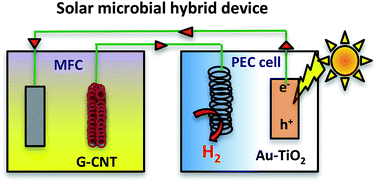A graphene/carbon nanotube biofilm based solar-microbial fuel device for enhanced hydrogen generation
Abstract
Poor extracellular electron transfer (EET) between microorganisms and the anode in microbial fuel cells (MFCs) has been the limiting factor hindering the widespread application of this technology. Thus, the employment of high performance anodes with efficient EET is crucial in enhancing the overall performance of MFCs. This work exploits the effect of MFC anodes with superior EET on significantly improving solar microbial hybrid technology formed by coupling a high performance MFC with a photoelectrochemical (PEC) cell. Based on the results, the hybrid device, which comprises a graphene/carbon nanotube (G/CNT) based MFC and a gold/titanium dioxide (Au/TiO2) PEC cell, generated a photocurrent density of ∼0.758 mA cm−2 and a H2 evolution rate of ∼11.2 μmol h−1. This performance is ∼2.5 times higher than that of an unmodified carbon bio-anode (∼0.294 mA cm−2, ∼4.6 μmol h−1) under 1 sun illumination (100 mW cm−2) at zero bias (0 V vs. Pt). The enhancement is attributed to the improved EET of the G/CNT biofilm due to two factors: (1) the large surface area of graphene sheets enables more bacterial cells to adhere onto the surface of the anode, and (2) the incorporation of CNTs into the G-biofilm also improves the conductivity of the biofilm, facilitating direct electron transfer between Shewanella oneidensis and the electrode. This successful demonstration points towards the possibility of further enhancing the H2 performance of hybrid devices through the employment of MFC anodes with higher EET.



 Please wait while we load your content...
Please wait while we load your content...